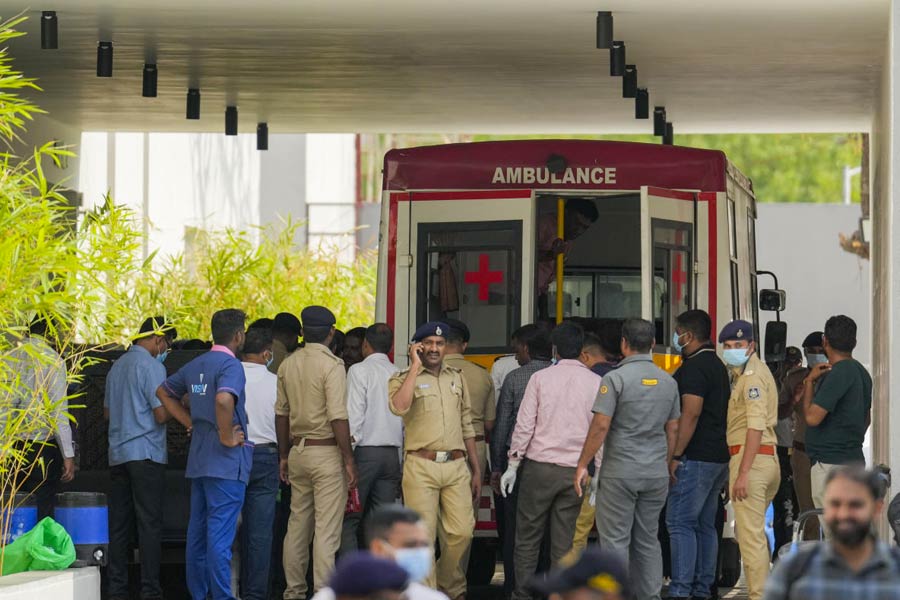 |
| The site of the buried 80-pillared hall at the excavated remains of the ancient Mauryan palace in Kumhrar. Picture by Piyush Kumar Tripathi |
Patna, Nov. 20: The excavated remains of the ancient Mauryan Palace at Kumhrar, the living signs of Patna’s glorious past, has fallen victim to the apathy of the Archaeological Survey of India (ASI) as well as the state government.
An 80-pillared assembly hall, which embodies perhaps the very first evidence of ancient Pataliputra — the city in which we live today, has been lost into oblivion, as the hall is buried under soil up to 20ft from nearly a decade at the Mauryan heritage site located along the Old Bypass Road at Kankerbagh.
Despite a complete ban on any kind of construction around 100m of this protected site, houses have mushroomed merely inches from its boundary walls on all sides. With the houses came the uncontrolled discharge of sewage water, leading to formation of a puddle on the south-western corner of the Mauryan site.
Several holes, too, can be seen in the peripheral wall, making the entire site prone to the threat of damage or theft.
Ironically, ASI, responsible for protecting Kumhrar Park, is itself responsible for the condition. Sources claimed in 2004, the ASI got the 80-pillar hall site filled with sand and soil citing perennial waterlogging. Since then, the hall has been completely buried underground and no efforts are being taken by the ASI to re-excavate it.
Similar negligence by the ASI and lack of coordination by the civic body has led to accumulation of sewage water inside the protected site. The holes in the wall depict the complete lack of seriousness by ASI officials.
“The entire world got to know about Pataliputra after the discovery of the Mauryan Palace at Kumhrar, especially the 80-pillar assembly hall. It is in this hall, where Emperor Asoka used to hold meetings with the people of Pataliputra, his capital. Some historical texts also mention that the third Buddhist council was also held here. Despite such rich historical significance, this site is facing utter neglect at present,” said Jaya Deva Mishra, a professor with the department of ancient history and archaeology at Patna University.
The famed pillared hall first came to light in 1912-15 during excavations carried out by British Archaeological Survey of India under D.B. Spooner with funds donated by the Tatas after remaining buried for two millennia. In this excavation, traces of 72 pillars were found.
Further, during the excavation carried out at the same site in 1951-55 by city-based K.P. Jayaswal Research Institute, eight more pillars of the hall and four additional ones belonging to the entrance or porch were exposed. Since then, it is popularly referred to as the Eighty Pillared Hall.
“In 2004, the then superintending archaeologist of ASI’s Patna circle, Urmila Sant, got the entire assembly hall buried under sand and soil claiming frequent waterlogging. Though the ASI had claimed that they taken such a step after consulting a number of historians, it was the worst thing that could have happened to this monument,” said Mishra.
According to records with the ASI, all pillars at the assembly hall were made of black spotted buff sandstone monoliths with a lustrous shine typical of the Mauryan period. Regarding the nature of this hall, it has been variously assigned as the palace of Asoka, audience hall, throne room of Mauryas, a pleasure hall or the conference hall for the third Buddhist council held at Pataliputra in the 3rd century BC during the reign of Asoka.
A senior official at the eastern regional headquarters of ASI said a proposal to re-excavate the pillar hall was sent to its headquarters a couple of months ago but approval is still awaited.
The disgrace to this protected site is not new. In 1999, a public interest litigation (PIL) was filed in Patna High Court for saving the Mauryan heritage site from decay. The PIL also stated that the ruins of the 80-pillared hall had submerged in water leading to decay.
With regard to the construction of houses in the prohibited area around Kumhrar, Atul Kumar Verma, the director of the state archaeological directorate, said: “According to the Ancient Monuments and Archaeological Sites and Remains Act, 2010, all buildings constructed within 100m from the protected sites after 1992 have to be removed and no new construction is to be allowed. The law and order situation, however, at times obstruct action on the illegal construction in the prohibited area.”










